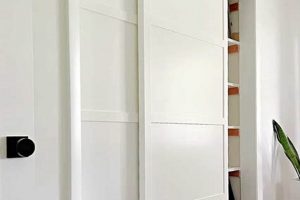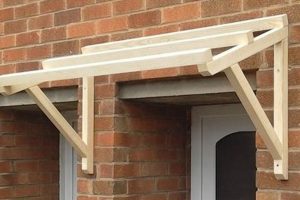The construction and installation of hinged panels designed to collapse against one another and fabricated by the homeowner represent a particular area of home improvement. Such projects enable modifications to interior spaces, allowing for flexible room division or expansion. For example, an individual might choose to build and install these doors to create a temporary office space within a larger living area.
Implementing these space-saving solutions offers several advantages. These include the potential to reduce construction costs compared to traditional wall installations, the opportunity to customize dimensions and aesthetics to match existing decor, and the satisfaction derived from completing a hands-on project. Historically, homeowners have sought methods to optimize living areas, and these customized door projects represent a modern iteration of that desire.
The subsequent sections will detail essential considerations for planning, material selection, construction techniques, and installation procedures to facilitate the successful completion of a hinged panel door project.
Essential Guidance for Hinged Panel Door Construction and Installation
The following guidelines offer crucial advice for homeowners undertaking the fabrication and mounting of space-saving, hinged panel door systems.
Tip 1: Precise Measurement and Planning: Prior to material procurement, accurate measurements of the intended opening are paramount. Develop a detailed plan, including panel dimensions, hinge placement, and track alignment, to minimize errors during construction.
Tip 2: Material Selection Based on Durability: Opt for materials that balance aesthetic appeal with structural integrity. Solid wood or high-density composites offer improved longevity and resistance to warping, particularly in high-traffic areas.
Tip 3: Hinge Selection and Placement: Select hinges specifically designed for folding door applications. Ensure uniform spacing between hinges to distribute weight evenly and facilitate smooth operation.
Tip 4: Track Installation Accuracy: Precise alignment of the upper track is critical for proper door function. Utilize a level and appropriate fasteners to secure the track to the header, preventing binding or misalignment.
Tip 5: Panel Assembly and Finishing: Construct door panels with careful attention to joinery. Secure all connections and apply a durable finish to protect the wood and enhance its aesthetic properties.
Tip 6: Hardware Selection for Functionality: Choose appropriate handles, latches, and guides that complement the door’s design and ensure ease of use. Verify compatibility with the chosen material and door thickness.
Tip 7: Testing and Adjustment: After installation, thoroughly test the door’s operation. Make any necessary adjustments to hinges, tracks, or guides to ensure smooth and effortless movement.
By adhering to these guidelines, homeowners can increase the likelihood of a successful outcome, resulting in a functional and aesthetically pleasing space-saving door solution.
The final section will address common challenges and troubleshooting techniques encountered during the implementation of such projects.
1. Precise Measurements
Accurate dimensional assessment constitutes a foundational element in projects involving hinged panel door construction by homeowners. Without precision, subsequent phases of construction are inherently compromised, potentially leading to functional deficiencies and aesthetic incongruities.
- Opening Dimensions and Panel Sizing
Incorrect measurements of the doorway or intended opening result in panels that are either too large to fit or too small to effectively close the space. For example, if the opening is measured as 72 inches wide but is actually 71.5 inches, the panels, if cut to accommodate the initial erroneous measurement, will not properly align and close. The homeowner needs to make necessary adjustments to get the fitting.
- Hinge Placement and Alignment
Variations in hinge placement, even fractions of an inch, can induce binding or uneven folding. The hinges need to be aligned accordingly for door to function well. Such inaccuracies create stress on the hardware, potentially reducing its lifespan and causing operational difficulties.
- Track Length and Position
Inaccurate track measurements lead to unstable door operation, potentially causing the door to jump the track or bind during opening and closing. Furthermore, misaligned tracks affect the overall aesthetic symmetry of the installation.
- Accounting for Hardware Clearances
Neglecting to account for the space occupied by hinges, handles, and other hardware results in a door that may not fully close or operate smoothly. This oversight requires remedial adjustments, potentially compromising the structural integrity of the door panels.
The criticality of accurate dimensional data in hinged panel door projects cannot be overstated. Precise measurement not only ensures proper fit and function but also contributes to the overall longevity and aesthetic appeal of the installation, minimizing the need for costly and time-consuming corrections.
2. Material Durability
The longevity and functionality of hinged panel door installations are directly correlated with the inherent durability of the chosen materials. For these homeowner projects, employing materials susceptible to warping, cracking, or degradation results in compromised structural integrity and diminished operational performance. The selection of appropriate materials, therefore, constitutes a critical decision point in the planning phase.
The cause-and-effect relationship is readily observable: substandard materials lead to premature failure. For example, utilizing low-density particleboard in high-humidity environments invariably results in swelling and deformation, rendering the door difficult to operate. Conversely, solid hardwood or engineered composites, resistant to moisture and physical stress, provide enhanced stability and extended service life. Consider a homeowner installing pine doors in a bathroom; the constant exposure to steam necessitates frequent maintenance and eventual replacement, a cost directly attributable to insufficient material durability. A more durable option, such as a PVC composite, would mitigate these issues. The hinge door also need to be durable in every weather, it must be flexible and firm for many years.
In summary, material selection directly affects the overall performance and lifespan of space-saving, hinged panel door systems. Compromising on material durability introduces a cascade of potential problems, undermining the investment of time and resources. Prioritizing robust materials is essential to achieving a functional and aesthetically pleasing installation. Durability affects its diy aspect, that needs more effort to work, the best material used, the best output resulted.
3. Hinge Selection
The successful creation of these door systems hinges, quite literally, on the appropriate selection of hinges. These components facilitate the folding action, bear the weight of the panels, and contribute significantly to the overall operational smoothness and longevity of the assembly. Therefore, hinge selection constitutes a critical juncture in the planning and execution phases of constructing such doors.
Incorrect hinge specification often leads to functional impairments. For instance, using standard door hinges, designed for swinging doors, on these folding door projects results in inadequate support and restricts the desired folding motion. This, in turn, induces undue stress on the hinges, leading to premature failure and operational difficulties. Conversely, hinges specifically engineered for this application provide the necessary offset, load-bearing capacity, and range of motion to ensure smooth and reliable operation. A homeowner who neglects this distinction may find their newly built doors difficult to open and close, or even structurally unsound within a short period. Proper hinge selection ensures the alignment to make the door more efficient. Moreover, inappropriate materials might affect the diy aspect.
In conclusion, the selection of hinges for a hinged panel door project is not merely a matter of attaching components; it directly impacts the functionality, durability, and overall success of the undertaking. Understanding the specific requirements of folding door systems and selecting hinges accordingly is essential for achieving a satisfactory and long-lasting outcome.
4. Track Alignment
The proper alignment of the track system represents a critical determinant of functionality and longevity in hinged panel door projects. Deviations from precise alignment induce a cascade of adverse effects, compromising operational smoothness and potentially leading to structural failures. In these homeowner-led projects, insufficient attention to track installation undermines the investment of time, resources, and materials, resulting in doors that bind, jam, or fail to operate as intended.
Consider, for instance, a scenario in which a track is installed even slightly out of level. This seemingly minor deviation creates unequal weight distribution across the door panels, leading to increased friction and accelerated wear on the hardware. Furthermore, misalignment introduces lateral stress on the hinges, predisposing them to premature failure. A real-world example might involve a homeowner who neglects to use a level during track installation; the resulting doors may initially appear functional, but over time, the strain on the hinges causes them to loosen or break, necessitating costly repairs or complete replacement of the system. Alternatively, an improperly aligned track prevents the doors from fully closing, compromising privacy and insulation. Furthermore, a failure to secure the track firmly to the header can also result in misalignment. All of this compromises both the usability and appearance of the “folding doors diy”.
In summary, accurate track alignment is not merely a procedural step; it constitutes a foundational element ensuring the successful and sustainable operation of homeowner-constructed hinged panel door systems. Neglecting this crucial aspect introduces a significant risk of operational deficiencies and structural vulnerabilities, diminishing the value and utility of the entire installation. The precision also enhances the result of the diy project.
5. Panel Assembly
The proper construction of individual door panels constitutes a critical phase in the successful execution of homeowner-led hinged panel door projects. Panel assembly encompasses cutting, joining, and finishing individual sections to form the operable leaves of the door system. A failure to adhere to established construction principles during this stage directly compromises the structural integrity, aesthetic appeal, and functional performance of the completed installation.
Consider, for example, a homeowner neglecting to employ precise joinery techniques when connecting panel sections. Inadequate joinery, such as poorly executed mortise-and-tenon or butt joints, weakens the panel’s structural integrity, predisposing it to warping, sagging, or outright failure under repeated stress from folding and unfolding. This is often evident in gaps forming between panel sections or in the door failing to maintain a consistent plane when closed. Conversely, meticulous attention to joinery, using appropriate adhesives and fasteners, ensures the panels remain rigid and true over extended periods. Another aspect is the finishing of these panels; improper sealing can lead to moisture absorption, causing swelling and distortion, especially in environments with fluctuating humidity. Selecting appropriate materials and assembling them correctly are vital.
In summary, panel assembly represents a foundational element in “folding doors diy” endeavors. The quality of the panel construction directly dictates the durability, aesthetic coherence, and operational effectiveness of the completed door system. Thorough planning, precise execution, and careful material selection during panel assembly minimize the risk of premature failure and maximize the long-term value of the installation. Thus it can be clearly seen the connection between “Panel Assembly” and “folding doors diy”.
6. Hardware Choices
The selection of appropriate hardware is paramount to the functional success and longevity of homeowner-constructed hinged panel door systems. Hardware componentsincluding hinges, handles, latches, guides, and track systemsdirectly influence the operability, security, and aesthetic coherence of these installations. Therefore, informed hardware choices are indispensable to successful “folding doors diy” projects.
- Hinge Compatibility and Load Capacity
The hinges employed must be specifically designed for folding door applications and possess adequate load-bearing capacity to support the weight of the door panels. Selecting hinges intended for standard swinging doors often results in premature failure, binding, and uneven folding. For instance, using lightweight hinges on heavy solid wood panels leads to sagging and operational difficulties within a short timeframe.
- Track System Durability and Precision
The track system, consisting of the upper and lower tracks and associated rollers or glides, must provide smooth and reliable operation over extended use. Inadequate track materials or imprecise track alignment compromises the door’s ability to open and close effortlessly, increasing the risk of jamming and premature wear. An example includes using plastic rollers on a frequently used door, which will degrade quickly compared to steel rollers.
- Latch and Handle Functionality and Aesthetics
Latches and handles facilitate secure closure and ease of operation while also contributing to the overall aesthetic design. Hardware choices that prioritize aesthetics over functionality often result in doors that are difficult to open or close, or that fail to provide adequate security. Chrome handles can offer a good aesthetic appeal, and may be combined with a robust latch that provides reliable closure.
- Guide Placement and Stability
Guides, typically installed at the bottom of the door panels, ensure smooth and stable movement within the track system. Improperly placed or poorly designed guides lead to instability, causing the doors to sway or bind during operation. A real-world example involves using plastic guides that wear down quickly, creating friction and hindering smooth door movement.
In conclusion, hardware selection constitutes a critical determinant of success in “folding doors diy” projects. Prioritizing durable, properly sized, and functionally appropriate hardware is essential for achieving a long-lasting, reliable, and aesthetically pleasing installation. Thoughtful hardware choices translate directly into enhanced operability, improved security, and extended lifespan for the completed door system. Furthermore, inappropriate material selection may hinder the project.
7. Smooth Operation
Achieving seamless and effortless movement is a primary objective in the construction and installation of hinged panel door systems by homeowners. This characteristic directly impacts usability, accessibility, and the overall satisfaction derived from the completed project. The absence of friction, binding, or obstruction during opening and closing cycles defines successful functionality, and is a core element of quality for “folding doors diy”.
- Precise Alignment of Components
Accurate alignment of tracks, hinges, and panels is essential for frictionless operation. Even slight misalignments can introduce binding forces, requiring excessive effort to operate the door and potentially causing premature wear on hardware. For example, a track that is not perfectly level will cause the panels to rub against each other or the track itself, impeding smooth movement.
- Proper Hinge Selection and Lubrication
The use of hinges specifically designed for folding door applications, coupled with regular lubrication, minimizes friction and ensures free movement. Standard door hinges are often unsuitable, lacking the necessary offset or load-bearing capacity. Applying a silicone-based lubricant to hinge points reduces friction and noise, contributing to seamless operation. Regular checking will maintain this smoothly and ensure long life of the DIY door.
- Adequate Clearances and Spacing
Sufficient clearances between panels and the surrounding framework are crucial to prevent rubbing or binding. Even minor contact between panels can significantly impede movement. Consistent spacing ensures that panels fold and unfold without obstruction, contributing to a user-friendly experience, that must be always considered.
- Appropriate Tensioning and Adjustment
For systems incorporating tensioning mechanisms or adjustable guides, proper calibration is necessary to maintain smooth and balanced operation. Over- or under-tensioning can create excessive resistance or instability. Fine-tuning tension and guide settings ensures that the door panels move fluidly and maintain their alignment throughout the folding cycle.
The attainment of smooth operation in hinged panel door systems represents the culmination of meticulous planning, precise execution, and careful component selection. By addressing alignment, lubrication, clearances, and tensioning, homeowners can enhance the usability, longevity, and overall value of their self-constructed installations. The smooth operation validates the time, effort, and resources invested in the “folding doors diy” project.
Frequently Asked Questions
The following addresses common inquiries and misconceptions surrounding homeowner construction of hinged panel door systems. These answers seek to provide clarity and informed guidance for prospective builders.
Question 1: What distinguishes hardware designed for hinged panel doors from standard door hardware?
Hardware specifically engineered for hinged panel doors is designed to accommodate the unique folding motion and load distribution inherent in such systems. Hinges provide a greater range of motion and offset, while track systems are engineered for smooth, lateral movement rather than swinging. Standard door hardware typically lacks these features, predisposing such projects to premature failure.
Question 2: What are the primary factors influencing the cost of these construction projects?
The cost is primarily influenced by the selection of materials, the complexity of the design, and the size of the door system. Solid hardwoods and intricate panel designs increase material expenses. Projects requiring extensive modifications to existing door frames or requiring specialized hardware also inflate the overall cost.
Question 3: How critical is precise measurement in these endeavors?
Precise measurement constitutes a non-negotiable prerequisite for success. Even minor inaccuracies in dimensional data propagate throughout the construction process, leading to misalignment, binding, and operational deficiencies. Accurate measurements are essential for ensuring a functional and aesthetically pleasing outcome.
Question 4: What safety precautions should be observed during construction and installation?
Appropriate personal protective equipment, including eye protection, hearing protection, and respiratory masks, should be worn at all times. Power tools must be operated in accordance with manufacturer instructions, and adherence to relevant building codes is mandatory. Safe lifting practices should be employed to prevent injury.
Question 5: What are the common operational issues encountered with homeowner-constructed hinged panel doors?
Common operational issues include binding, sticking, uneven folding, and sagging. These problems typically arise from misalignment, inadequate hinge selection, or the use of dimensionally unstable materials. Regular maintenance, including lubrication and adjustment, can mitigate these issues.
Question 6: Are specialized skills required for this type of project?
While advanced carpentry skills are not necessarily required, a foundational understanding of woodworking principles, including accurate measuring, cutting, and joinery techniques, is essential. Projects involving electrical work or structural modifications may necessitate the engagement of qualified professionals.
In summary, constructing hinged panel doors requires careful planning, precise execution, and adherence to established construction principles. Addressing common concerns and misconceptions is crucial for a successful outcome.
The following sections will delve into best practices for maintaining these installations to ensure long-term performance.
Conclusion
The preceding exploration has illuminated the multifaceted nature of “folding doors diy.” Success in such undertakings demands meticulous planning, precise execution, and a comprehensive understanding of the materials and techniques involved. Ignoring fundamental principles of construction increases the likelihood of operational deficiencies, structural weaknesses, and diminished aesthetic value.
While the allure of cost savings and customization often motivates homeowners to embark on these projects, a realistic assessment of skills, resources, and time commitments is crucial. Informed decision-making, coupled with diligent adherence to best practices, represents the path toward achieving functional and aesthetically pleasing hinged panel door installations. Proceed with caution, prioritize quality, and recognize the inherent complexities involved.







